ORIGINAL ARTICLE
LIMA, Gabriela Elenor dos Santos [1], MARTINS, Carlos Henrique Lopes [2], DENDASCK, Carla Viana [3], OLIVEIRA, Ciane Martins de [4], OLIVEIRA, Euzébio de [5]
LIMA, Gabriela Elenor dos Santos. Et al. Profile of patients seen at a medical genetics outpatient clinic at a University Center in Belém, Pará, Amazon. Revista Científica Multidisciplinar Núcleo do Conhecimento. Year 06, Ed. 03, Vol. 11, pp. 48-62. March 2021. ISSN: 2448-0959, Access link: https://www.nucleodoconhecimento.com.br/health/genetics-outpatient, DOI: 10.32749/nucleodoconhecimento.com.br/health/genetics-outpatient
SUMMARY
Medical Genetics (GM) has become a recognized medical specialty, with important concepts and approaches in the diagnosis and treatment of many common and rare diseases. Genetic diseases follow inheritance patterns, and may be autosomal recessive, autosomal dominant, linked to the X chromosome or Y chromosome, or multifactorial. The aim of this study was to determine the profile of patients treated at a GM outpatient Clinic at a University Center in Belém, Pará State. Data were collected from patient records, seen between 2014 and 2019, using the researchers’ own questionnaire, with data analyzed and tabulated through the Microsoft Excel program. A total of 101 medical records were analyzed, with predominance of females (51 patients). In addition, most of the care was for children (41.5%). Regarding ethnicity, only the variables “white” and “brown” were observed, with a higher prevalence of brown patients (78 of the total). Also, Belém was the most prevalent city in the naturalness of patients (61 records). The specialties with the highest number of referrals to the GM outpatient clinic were Endocrinology and Neurology, with Neuropsychomotor Development Delay being the most frequent diagnosis. In 42 medical records, the age at diagnosis was not present. Of the 101 patients, only 16 had genetic counseling and in the remaining 85 there was no record on this information. Finally, maternal age at birth was not found in most medical records (absent in 61.38%). Thus, developing a profile of the patient seen in a GM outpatient clinic is important, since it becomes possible to identify any failures in the service provided, in addition to adapting the doctor-patient relationship.
Keywords: Medical genetics, outpatient clinic, genetic diseases.
INTRODUCTION
Genetics emerged in medicine in the early twentieth century, when it was perceived that mendelian laws of heredity could explain the recurrence of some family disorders. Over the next 100 years, Medical Genetics (GM) has ceased to be a small subspecialty focused on only a few rare hereditary disorders, to become a recognized medical specialty, with important concepts and approaches in the diagnosis and treatment of many diseases, both common and rare (NUSSBAUM et al., 2016).
GM was recognized as a medical specialty by the Federal Council of Medicine in 1983 and in 1986, to expand the knowledge of the specialty, the Brazilian Society of Medical Genetics was created. More recently, GM has been acting relevantly in genetic counseling (BRAZILIAN SOCIETY OF MEDICAL GENETICS, 2020).
According to the World Health Organization (WHO), genetic counseling concerns a genetic clarification, which aims to prevent genotypes responsible for diseases or birth defects, through prospective or retrospective identification of unions that can produce these changes. In addition, counseling also covers the reporting of problems related to the occurrence or risk of a genetic disease occurring in the family. Therefore, it is necessary to participate in a multidisciplinary team of professionals capable of advising the patient and his family regarding the diagnosis, the course of the disease, the available approaches, the risk of recurrence and alternatives to such risk. In this context, it is highlighted that the professional who offers counseling cannot suggest, indicate or demand conduct to the patients he treated (BERTOLLO et al., 2013).
A disease of genetic origin originates from changes in the sequences of Deoxyribonucleic Acid (DNA), the genetic material of each individual or mutations at the level of sexual or autosomal chromosomes (GRIFFITHS; WESSLER; DOEBLEY, 2016).
Genetic diseases follow patterns of inheritance, may be: (1) autosomal recessive, which manifest only in homozygous individuals for an autosomal gene, i.e., affected individuals have two copies of the mutant gene, such as cystic fibrosis, which results from a mutation in the CFTR gene on chromosome 7, and classical phenylketonuria, related to mutations in the gene located on chromosome 12; (2) autosomal dominant, in which mutant genes are also on autosome chromosomes, however, a single gene copy is capable of causing the disease, such as Huntington’s disease; (3) X-linked, also known as sex-related inheritances, in this case chromosomes are located in a non-homologous region of the X chromosome and mutations are dominant in males, the main examples are color blindness, hemophilia and Duchenne muscular dystrophy; (4) linked to Y, or holândrica inheritance or inheritance restricted to sex, in which the occurrence of the disease is related to the Y chromosome in its non-homologous x chromosome; and (5) polygenic or multifactorial, which result from mutations in different genes or arise from the interaction of several environmental factors, hence the highlight for the Amazon region of Brazil, due to its great peculiarity and diversity of ecological and non-ecological environments that are directly linked to people’s lives and can contribute significantly to phenotypic changes in multiple genes , for example, coronary heart disease, cancer and schizophrenia (LOBO, 2008; BERTOLLO et al., 2013; NUSSBAUM et al., 2016).
Genetic diseases can also originate from chromosomal alterations, which are classified as: (1) numerical mutations, in which there is a change in the number of chromosomes in the cell; and (2) structural mutations, in which there is a change in the shape or size of chromosomes. There are also cases in which a mixture of cell lines may occur, with the presence of a normal lineage and another altered, an event called mosaicism (BORGES-OSÓRIO; ROBINSON, 2013).
The chromosomal variations of numerical character are classified into two major categories: euploidias and aneuploidias. Euploidias involve whole genomes, affecting all chromosomes of an individual, being a condition incompatible with life. Aneuploides involve changes in the chromosomal number, with increase or loss of one or more chromosomes, without involving the haploid set (JORDE; CAREY; BAMSHAD, 2016).
In men, these chromosomal changes, especially in larger chromosomes, are almost always lethal, differently from what occurs on smaller chromosomes, such as chromosome 21, which can remain in the cell lineage, although it results in births with physical and mental malformations. Among the consequences generated from chromosomal alterations, there are Down, Edwards, Patau and Klinefelter syndromes (ZANELLA; TERENCIO, 2016).
From the above, it is worth mentioning that, because genetic diseases are an uncured condition, follow-up is an essential part of treatment and lasts throughout the patient’s life. Therefore, the present study aims to determine the profile of patients seen at a GM outpatient clinic, in a University Center of Belém, Pará, Amazonia.
MATERIAL AND METHOD
This is a descriptive and retrospective study, in which medical records of patients treated from January 2014 to March 2020 were analyzed at the GM outpatient clinic of the Center for Medical Specialties of a University Center located in the city of Belém, Pará. All patients (maintained their anonymity) signed an Authorization Form so that their respective medical records could be analyzed, for data collection, for the development of this research. This project was submitted and approved by the Ethics Committee on Research with Human Beings, according to the approval opinion of number 2,917,287. As well as the protocol of this study strictly followed the norms of Resolution No. 466/12 of the National Health Council of Brazil (BRASIL, 2012), which establishes standards for research involving human beings.
The medical records of patients treated only during the period referred to for this research were included and the medical records of patients seen in outpatient clinics of other medical specialties were excluded. The profile of each patient was analyzed for the following variables: gender, age, ethnicity, origin, origin of medical referral, diagnosis, age at diagnosis, age of the mother at birth, complications in pregnancy, genetic counseling and follow-up by the multidisciplinary team.
Patients were classified according to age, according to WHO criteria, in children (up to 9 years), adolescents (10 to 19 years old), adults (20 to 59 years old) and elderly (from 60 years old).
Data collection, based on the analysis of medical records, was performed using the researchers’ own questionnaire, containing objective and subjective questions. The data were then tabulated and analyzed with the help of the Microsoft Excel 2016 program.
RESULTS
Over the period, 101 medical records were analyzed. Of these, 49 were male and 51 female patients (Figure 1). In addition, it was found that most of the visits were for children, with 41.5% of the total, followed by 31.68% for adolescents and 20.79% for adults. The elderly represented the lowest percentage, with 5.94% of the visits (Figure 2). It is worth mentioning that, of the total number of children, the highest frequency of records was of patients aged 4 years, found in the analysis of 10 medical records. In the other age groups, the distribution between ages was similar.
Figure 1: Distribution of patients seen at the Medical Genetics outpatient clinic by gender.
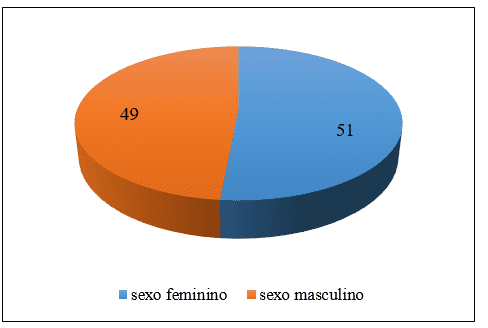
Figure 2: Distribution of patients seen at the Medical Genetics outpatient clinic, by age group.
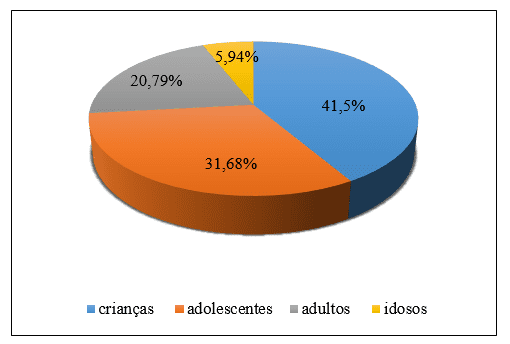
Regarding ethnicity, during the analysis of medical records, the variables “white” and “brown” were found, with no record of black patients, besides having medical records without filling out the question. Thus, there were 10 white patients, 78 brown patients and 13 in which the information was not included.
Belém was the most prevalent city in the naturalness of patients. The capital of Pará concentrated 61 records, followed by Abaetetuba with 7 patients. It is emphasized that the outpatient clinic attended in the analyzed period, mostly cities that make up the metropolitan region of Belém. Only 1 case was an exception: that of a patient referred from the Genetics service of a university of Campinas, in the state of São Paulo. Other cities found in the study were Altamira (1), Ananindeua (4), Barcarena (3), Benevides (1), Bragança (3), Cametá (4), Capanema (1), Castanhal (2), Cotijuba (1 ), Marabá (1), Marituba (1), Mosqueiro (2), Ourém (1), Paragominas (3), Portel (1), Santo Antônio do Tauá (1), Tucuruí (1) and Vigia (1) (Figure 3).
Figure 3: Distribution of patients seen at the Medical Genetics outpatient clinic, by origin.
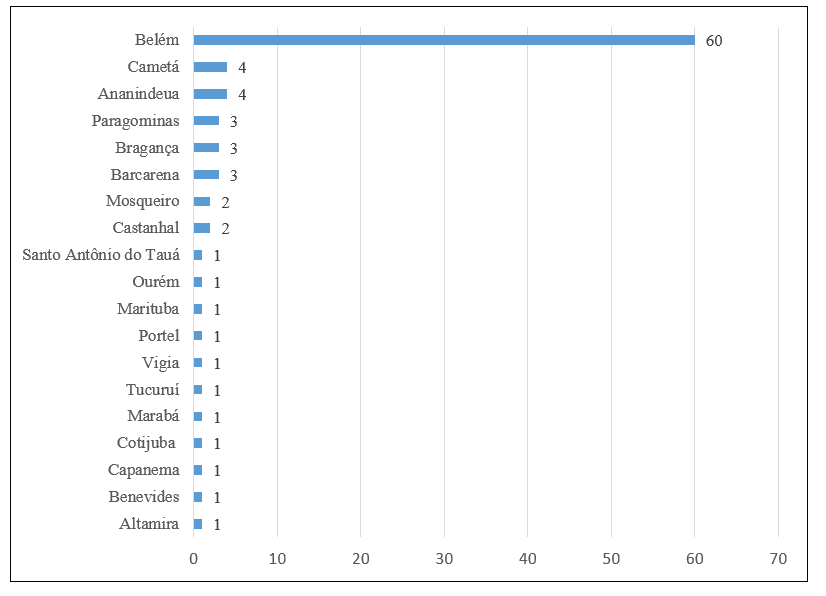
It was also found that Endocrinology and Neurology are the specialties with the highest number of medical referrals to the GM outpatient clinic. Neurology referred 26 patients, with a predominance of children, 25 of which were pediatric patients (10.89%) and only 1 adult. Endocrinology sent 22 patients. However, there is also a large number of medical records in which this information was not found, totaling 26.73%. In addition to these, other medical specialties that referred to GM were Gynecology (2), Mastology (2), Neonatology (2), Clinical Medicine (1), Dermatology (1), Gastropediatrics (1), Genetics of the city of Campinas (1), Orthopedics (1), Pulmonology (1), Rheumatology (1), Elderly Health (1) and Basic Health Unit (1) (Figure 4).
Figure 4: Distribution of patients seen at the Medical Genetics outpatient clinic, by referral.
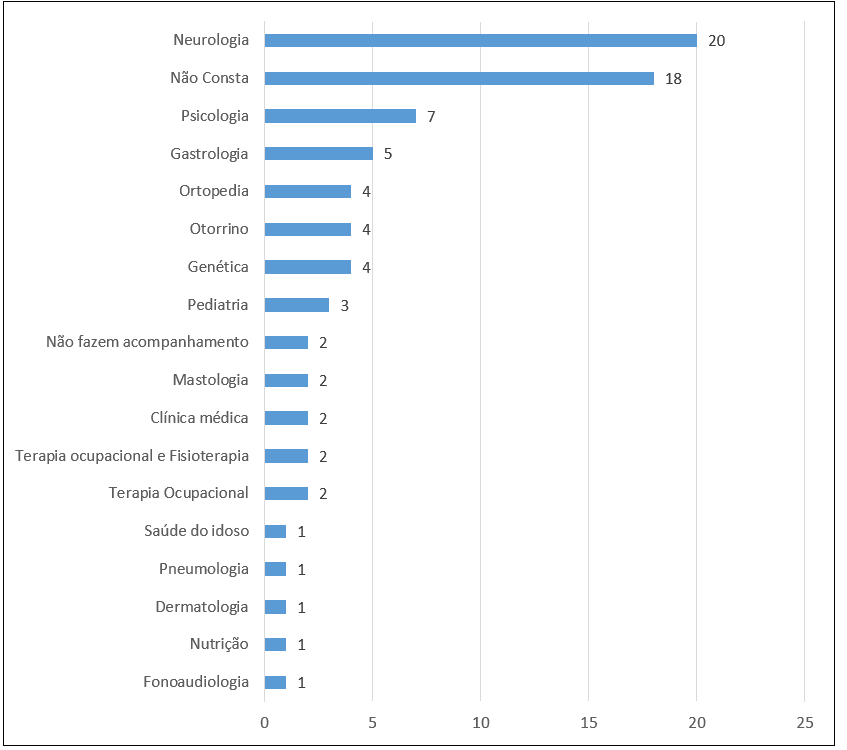
The diagnoses were diversified. They were rarely seen in isolation and were often associated with another condition. In the GM outpatient clinic, there was a slight prevalence of Neuropsychomotor Development Retardation (ADNPM), with 8 records and, in only 2 cases, ADNPM was the only disease diagnosed in the patient. In the other 6, it was associated with short stature and dysmorphia (3), congenital hypothyroidism (1) and precocious puberty (2). Some syndromes have been found, dysmorphic syndrome (3), Noonan syndrome (3), Cornelia Lange syndrome (2), Sotos syndrome (2), Charge syndrome (1), Marfan syndrome (1), Aarskog syndrome (1), Down (1), Beckwith-Wiedermann syndrome (1), Turner syndrome (1), Prader-Willi syndrome (1), Williams syndrome (1) and hyperkinetic syndrome associated with attention deficit hyperactivity disorder (1). Five cases of chromosome s46, XY and another 5 cases of sindromic intellectual disability were found. In addition to 4 records of investigation of zyka virus embryopathy, 3 investigations of family disease, of which 2 breast cancers in sisters. Inborn errors of metabolism represented 4 cases, as well as short stature of autosomal dominant inheritance. Acondroplasia, X-fragile and epilepsy associated with cognitive deficit totaled 3 patients each. Also, multiple endocrine neoplasia type 1 and multiple endocrine neoplasia type 2A, right unilateral microtia, congenital megacolon with skeletal alterations, dunning type partial lipodystrodia with oligomenorrhea, distal hereditary neuropathy and neurofibromatosis presented 1 case each (Figure 5).
Other conditions found were: multiple exostosis (2), congenital adrenal hyperplasia (2), methylmalonic acidemia (1), X-linked adrenoleukodystrophy (1), multifactorial behavior alteration (1), distal predominance arthrogriposis associated with signs brida (1), delay in sexual development due to hypogonadism (1), non-fibrotic bronchiectasis (1), Dohi’s disease (1), growth hormone deficiency with low bone mineral density with myasthenic syndrome associated with Kearnes-Sayre syndrome (1) , central hypothyroidism with funicular myelose and ephesicular microadenoma (1), medullary thyroid carcinoma (1), nonprogressive chronic encephalopathy (1), cystic fibrosis (1), lymphedema-associated genodermatosis (1) and hypodystrophy (1) (Figure 5). Within the data collection period, 10 patients were still under investigation or without completed diagnosis.
Figure 5: Distribution of patients seen at the Medical Genetics outpatient clinic, by diagnosis.
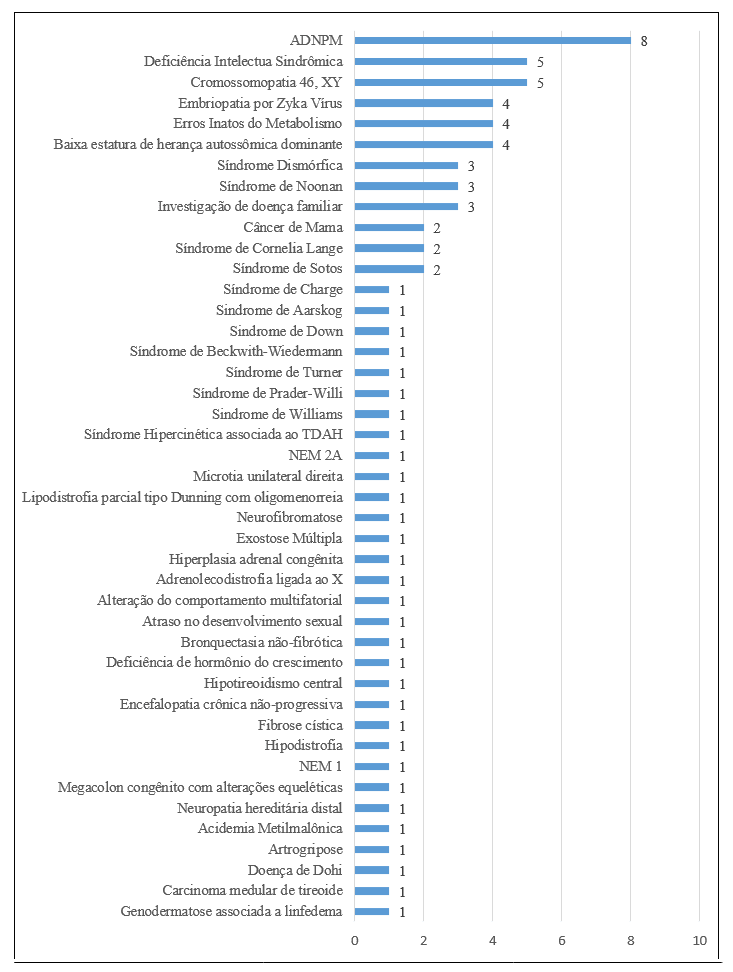
In 42 medical records, age at diagnosis was not present, 2 patients were diagnosed still in the womb and 4 more at birth. Another 11 patients were diagnosed under 2 years of age; 13 patients, between 2 and 9 years old; 18 during adolescence, with a higher number at 14 years of age, with 6 diagnoses. In the adult age group, there were 11 diagnoses and only 1 in an elderly patient at 63 years of age (Figure 6).
Figure 6: Distribution of patients seen at the Medical Genetics outpatient clinic, by age at diagnosis.
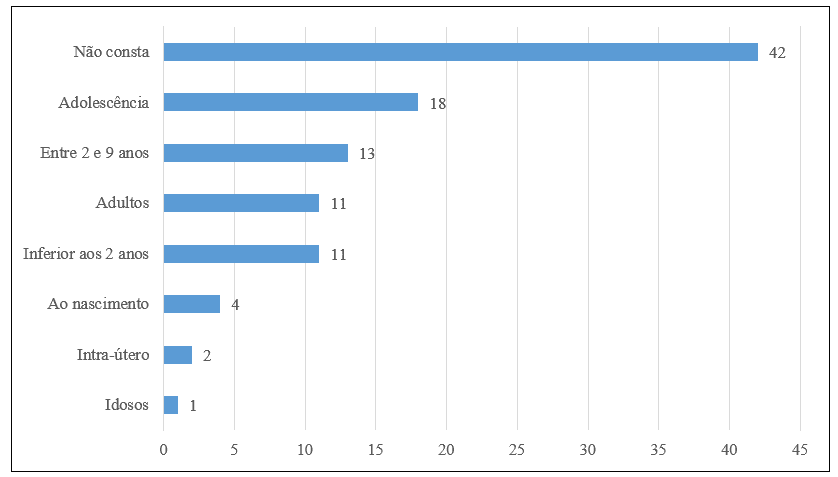
Of the 101 patients, only 16 had genetic counseling and in the remaining 85 there was no record on this information.
Patients were most frequently followed by Endocrinology, 21 records, followed by Neurology with 20 patients, and Psychology followed 7 patients. In addition, 5 patients were monitored with Gastronomy, 4 with Genetics, Otorrino and Orthopedics, another 3 with Pediatrics, 2 with Occupational Therapy, 2 for Physiotherapy and Occupational Therapy simultaneously, 2 with the Medical Clinic, 2 with Mastology, 1 with Speech Therapy, 1 with Nutrition, 1 with Dermatology, 1 with Pulmonology and 1 with Elderly Health. In addition, 18 medical records did not have the variable filled out and 2 did not follow-up (Figure 7).
Graph 7: Distribution of patients seen at the Medical Genetics outpatient clinic, by follow-up.

The information about the mother’s age was absent in most medical records, not in 61.38% of the total. In the medical records in which the information was present (38.62%), maternal ages between 16 and 19 years totaled 7.92%, while ages between 20 and 59 years were in 30.7% of the records.
In 36 medical records there was no information on complications during pregnancy and in 25 cases there were no complications. Those who had (40) were varied: urinary tract infection (8), uterine bleeding (6), preterm birth (5), preeclampsia (4), delay in contractions of expulsion of the fetus (2), oligohydramnio (2), perinatal cytoxia (1), central cyosis (1), nephrotic colic (1), child trapped in the delivery canal (1), placental detachment (1), pain during pregnancy (1), alcohol consumption and smoking (1), hospitalization for maternal asthma crisis (1) , canine bite (1), smoking, metrorragia and child with onfocele in USG – in the same patient – (1), use of capillary dye and discoloration of body hair (1), chickenpox (1), and Zyka maternal virus (1).
DISCUSSION
Belém is a brazilian municipality, capital of the State of Pará, located in the northern region of the country, more specifically in the Region of the Brazilian Amazon. It is the most populous municipality of Pará and the second in the North region, with a population of 1.492,745 inhabitants (INSTITUTO BRASILEIRO DE GEOGRAFIA E ESTATÍSTICA, 2020). The city has an economic and service network – including health care – that serves the cities of its metropolitan region.
It is considered that a geneticist physician is necessary for every 100,000 inhabitants, including outpatient, hospital and genetic counseling (CARVALHO et al., 2016; CONSELHO FEDERAL DE MEDICINA, 2020). In the State of Pará, currently, only 3 physicians are practicing the specialty of GM, according to data from the Federal Council of Medicine (CONSELHO FEDERAL DE MEDICINA, 2020). In addition, all work in the capital of Pará. Thus, the scarcity of the service is noted, since the specialty benefits the entire collectivity and speeds up the health system. This is because the early diagnosis of diseases of genetic origin allows better management of patients and prevents or minimizes possible sequelae and also reduces costs with possible more complex treatments.
Another relevant data pointed out by the study is the lack of genetic counseling by the multidisciplinary team assisting the patient, since only about 16% of the patients had access to this service, for the others, the information was absent. This fact may be related to the scarcity of the service, since not all patients with genetic disease have the service at their disposal, and it is necessary to expand the network of care to this public, given the importance of multiprofessional counseling, especially with regard to the prevention of genotypes responsible for diseases or birth defects (JORDE; CAREY; BAMSHAD, 2016).
The study also revealed the high rate of referrals between GM and other specialties of the Medical Center in which the research was conducted. The specialties with the highest number of referrals were Endocrinology and Neurology, besides being observed the referral of GM to other professionals, such as psychologists and occupational therapists. Being, being, being notorious the importance of multiprofessional approach of patients, since some genetic diseases are related to one or more systems of the organism (BERTOLLO et al., 2013).
Regarding the maternal age at the patient’s birth, more than half of the medical records did not contain the information (62 medical records), but the medical records that presented this data revealed that the mother’s age was greater than 35 years in 6 medical records. This data becomes relevant, since studies indicate an association between advanced maternal age and the development of genetic disorders. Studies reveal that the prevalence of genetic complications in fetuses of mothers with 20 years is 1 in 1,000, while at 35 years of age, this proportion reaches 1 in 350 pregnant women. Once again corroborating the importance of genetic counseling (MENDES, 2017; BARBOZA et al., 2020).
CONCLUSION
The elaboration of a profile for the patient attended in a Medical Genetics outpatient clinic is extremely important, since, from this knowledge, it becomes possible to identify possible failures in the service provided, in addition to adapting the doctor-patient relationship. It is also emphasized that the correct acceptance and execution of the treatment and follow-up of a genetic disease depend on personal and social factors, as well as the phase in which the disease is contemplating the continuity of treatment. Thus, the need to determine the profile of the patient being treated is corroborated.
Thus, the results of the present study demonstrated the importance of adequate lyfilling the medical records of the patient attended at the Medical Genetics outpatient clinic, in order to avoid the loss of crucial information, which can help determine the diagnosis or assist in the conduction of the case in the follow-up of the patient.
Another important factor highlighted during the study is the frequent overlap of diagnoses, since patients usually attend more than one pathology, it is important to particularize the care, taking attention to this fact, in order to avoid possible iatrogenic and intercorrências, with drug interactions during treatment.
REFERENCES
BARBOZA, B. P.; CALIL, C.; TRIGO, I. G. P. F.; ELLER, J. X.; SILVA, L. R.; VAZ, M. R.; ESTEVES, A. P. V. S. Idade materna avançada e seus desfechos. Cadernos da Medicina-UNIFESO, v. 2, n. 3, 2020.
BERTOLLO, E. M. G.; CASTRO, R; CINTRA, M. T. R.; PAVARINO, É. C. O processo de aconselhamento genético. Arq. Cienc. Saúde, v. 20, n. 1, p. 30-6, 2013.
BORGES-OSÓRIO, M. R; ROBINSON, W. M. Genética Humana. 3ª edição, Porto. Alegre, Editora Artmed, 2013.
CARVALHO, A. C.; VIEIRA, E.; ALTENHOFEN, T. M. G.; JUNG, M. S. Perfil clínico-epidemiológico dos pacientes atendidos pelo Serviço de Genética Médica do Ambulatório Materno Infantil da Universidade do Sul de Santa Catarina. Arquivos Catarinenses de Medicina, v. 45, n. 2, p. 11-24, 2016.
CONSELHO FEDERAL DE MEDICINA. Disponível em: < https://sistemas.cfm.org.br/normas/arquivos/pareceres/BR/2018/17_2018.pdf > Acesso em 20 de março de 2020.
GRIFFITHS, A. J. F.; WESSLER, S. R.; DOEBLEY, J. Introdução à Genética. 11ª edição. Guanabara Saúde Didático, 2016.
INSTITUTO BRASILEIRO DE GEOGRAFIA E ESTATÍSTICA. Disponível em: <https://www.ibge.gov.br/cidades-e-estados/pa/belem.html> Acesso em: 20 de março de 2020.
JORDE, L. B.; CAREY, J. C.; BAMSHAD, M. J.; Genética Médica. 5ª edição, Rio de Janeiro, Editora Elsevier. 2016.
LOBO, I. Environmental influencies on gene expression. Nature Education 1(1):39, 2008.
MENDES, C. C. Estudo genético e epigenético de fatores de risco materno para a síndrome de Down. 2017. 32 f. Tese (Programa de Pós-Graduação em Ciências da Saúde) – Faculdade de Medicina de São José do Rio Preto, São José do Rio Preto.
NUSSBAUM, R. L.; MCINNES, R. R.; HUNTINGTON, F. W.; THOMPSON, M. W. Thompson & Thompson. Genetics in Medicine. Philadelphia: Elsevier. 2016.
SOCIEDADE BRASILEIRA DE GENÉTICA MÉDICA. Disponível em: <http://www.sbgm.org.br>. Acesso em: 20 março, 2020.
ZANELLA, J.; TERENCIO, M. L. Genética clínica: investigação dos padrões de herdabilidade de doenças humanas-mutações genéticas e cromossômicas. Artigo completo publicado em: Anais do V Encontro de Iniciação Científica e I Encontro Anual de Iniciação ao Desenvolvimento Tecnológico e Inovação – EICTI. 2016.
[1] Medical Academic at the University Center of the State of Pará – CESUPA.
[2] Medical Student at the University Center of the State of Pará – CESUPA.
[3] Theologian, PhD in Clinical Psychoanalysis. He has been working for 15 years with Scientific Methodology (Research Method) in the Scientific Production Guidance of Master’s and Doctoral students. Specialist in Market Research and Research focused on health.
[5] PhD in Medicine/Tropical Diseases. Professor and Researcher at the Federal University of Pará – UFPA.
Submitted: March, 2021.
Approved: March, 2021.















